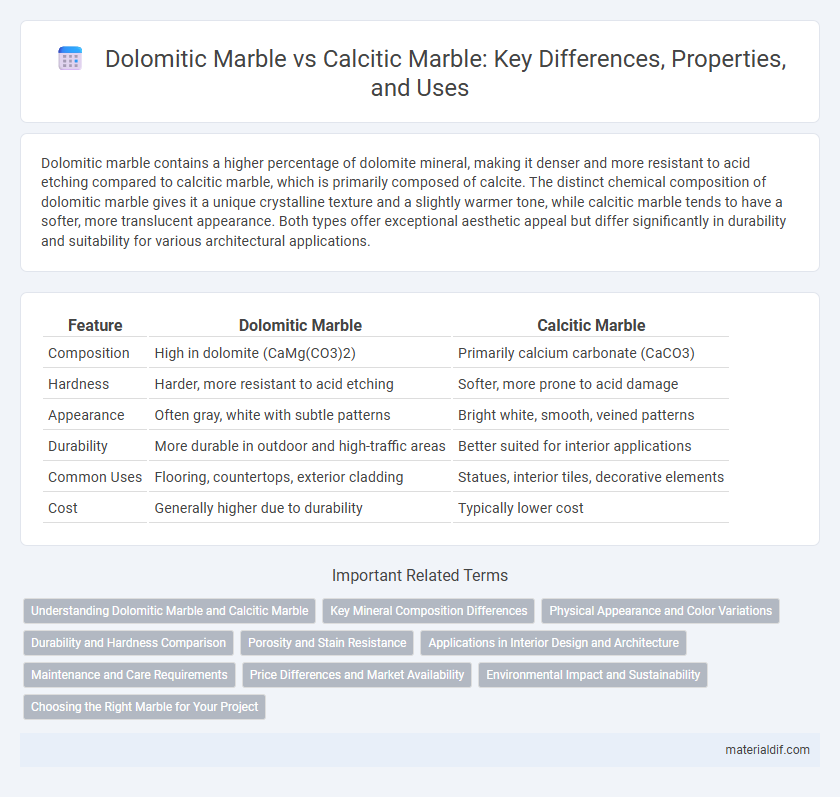Dolomitic marble contains a higher percentage of dolomite mineral, making it denser and more resistant to acid etching compared to calcitic marble, which is primarily composed of calcite. The distinct chemical composition of dolomitic marble gives it a unique crystalline texture and a slightly warmer tone, while calcitic marble tends to have a softer, more translucent appearance. Both types offer exceptional aesthetic appeal but differ significantly in durability and suitability for various architectural applications.
Table of Comparison
| Feature | Dolomitic Marble | Calcitic Marble |
|---|---|---|
| Composition | High in dolomite (CaMg(CO3)2) | Primarily calcium carbonate (CaCO3) |
| Hardness | Harder, more resistant to acid etching | Softer, more prone to acid damage |
| Appearance | Often gray, white with subtle patterns | Bright white, smooth, veined patterns |
| Durability | More durable in outdoor and high-traffic areas | Better suited for interior applications |
| Common Uses | Flooring, countertops, exterior cladding | Statues, interior tiles, decorative elements |
| Cost | Generally higher due to durability | Typically lower cost |
Understanding Dolomitic Marble and Calcitic Marble
Dolomitic marble, composed primarily of the mineral dolomite, offers greater hardness and chemical resistance compared to calcitic marble, which is mainly made of calcite. These differences influence their durability and response to acids, with calcitic marble being more susceptible to etching and weathering. Understanding the mineral composition of dolomitic versus calcitic marble is essential for selecting the appropriate material for architectural or sculptural applications.
Key Mineral Composition Differences
Dolomitic marble primarily consists of the mineral dolomite (CaMg(CO3)2), while calcitic marble is mainly composed of calcite (CaCO3). The presence of magnesium in dolomitic marble imparts greater hardness and chemical stability compared to the softer, more reactive calcitic marble. These mineral composition differences influence their durability, acid resistance, and suitability for various architectural and sculptural applications.
Physical Appearance and Color Variations
Dolomitic marble features a finer grain and a slightly translucent appearance compared to calcitic marble, often exhibiting subtle gray, pink, or beige hues. Calcitic marble displays a broader color range with more pronounced veining, including whites, creams, and bolder tones like green or black. The physical appearance of dolomitic marble tends to be denser and more compact, while calcitic marble is characterized by a softer texture and more varied surface patterns.
Durability and Hardness Comparison
Dolomitic marble exhibits greater durability and hardness compared to calcitic marble due to its higher magnesium carbonate content, which enhances resistance to abrasion and weathering. Calcitic marble, composed mainly of calcium carbonate, is softer and more prone to etching and surface wear in acidic environments. The superior strength of dolomitic marble makes it ideal for heavy-use applications where long-term stability is critical.
Porosity and Stain Resistance
Dolomitic marble exhibits lower porosity compared to calcitic marble, making it less prone to water absorption and reducing the risk of stains. The dense crystalline structure of dolomitic marble enhances its stain resistance, especially against acids and oils. In contrast, calcitic marble's higher porosity increases vulnerability to staining and requires more frequent sealing to maintain its appearance.
Applications in Interior Design and Architecture
Dolomitic marble, rich in magnesium carbonate, offers enhanced durability and resistance to acid etching, making it ideal for high-traffic flooring, countertops, and sculptural elements in interior design and architecture. Calcitic marble, composed primarily of calcium carbonate, is prized for its softer texture and brighter white coloration, frequently used for intricate wall cladding, decorative moldings, and fireplace surrounds. Both types are favored for their luxurious appearance, but dolomitic marble is preferred in environments demanding greater strength and longevity.
Maintenance and Care Requirements
Dolomitic marble offers enhanced resistance to chemical etching and weathering compared to calcitic marble, making it easier to maintain in high-traffic or outdoor environments. Calcitic marble, being more susceptible to acid damage and scratching, requires more frequent sealing and gentle cleaning with pH-neutral products to preserve its surface integrity. Regular maintenance of dolomitic marble involves less intensive care, reducing long-term restoration costs and extending the stone's natural luster.
Price Differences and Market Availability
Dolomitic marble typically commands higher prices than calcitic marble due to its increased durability and resistance to chemical weathering, making it more valuable in premium construction and sculptural applications. Market availability of dolomitic marble is more limited compared to calcitic marble, as it is quarried less frequently and often sourced from specific geographic regions such as the Dolomite Alps. Calcitic marble enjoys broader market presence and more competitive pricing, benefiting from widespread deposits and easier extraction processes.
Environmental Impact and Sustainability
Dolomitic marble, composed mainly of calcium magnesium carbonate, typically has a lower carbon footprint during quarrying due to its more stable geological formation compared to calcitic marble, which is primarily calcium carbonate and often requires more intensive processing. The slower weathering rate of dolomitic marble enhances its durability and reduces the need for frequent replacement, contributing to long-term sustainability. Energy consumption in the extraction and finishing processes is generally lower for dolomitic marble, making it a more environmentally friendly choice in construction and design applications.
Choosing the Right Marble for Your Project
Dolomitic marble offers superior durability and resistance to acid compared to calcitic marble, making it ideal for high-traffic areas and outdoor applications. Calcitic marble, known for its pure white appearance and softer texture, suits decorative elements and interior walls with minimal wear. Selecting the right marble depends on project requirements such as strength, aesthetic preferences, and environmental exposure.
Dolomitic Marble vs Calcitic Marble Infographic

 materialdif.com
materialdif.com